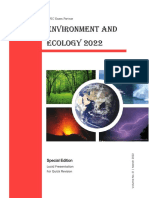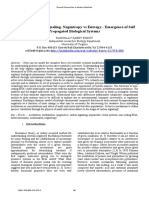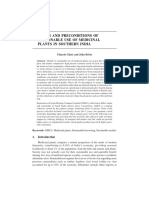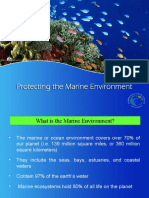0 ratings0% found this document useful (0 votes)
42 viewstmp4E3F TMP
tmp4E3F TMP
Uploaded by
Frontiers1) An international symposium was held to discuss biodiversity, its current status, utilization, and impacts of climate change. Over 350 national delegates and 35 lead speakers participated.
2) The symposium highlighted the importance of biodiversity for sustaining life and the environment. Climate change and human activities threaten global biodiversity loss.
3) Several researchers were honored for their work, including studies on protective roles of plant compounds, livestock management, and microbial diversity applications. The exchange of knowledge at the symposium provided new perspectives on preserving global biodiversity.
Copyright:
© All Rights Reserved
Available Formats
Download as PDF, TXT or read online from Scribd
tmp4E3F TMP
tmp4E3F TMP
Uploaded by
Frontiers0 ratings0% found this document useful (0 votes)
42 views2 pages1) An international symposium was held to discuss biodiversity, its current status, utilization, and impacts of climate change. Over 350 national delegates and 35 lead speakers participated.
2) The symposium highlighted the importance of biodiversity for sustaining life and the environment. Climate change and human activities threaten global biodiversity loss.
3) Several researchers were honored for their work, including studies on protective roles of plant compounds, livestock management, and microbial diversity applications. The exchange of knowledge at the symposium provided new perspectives on preserving global biodiversity.
Original Title
tmp4E3F.tmp
Copyright
© © All Rights Reserved
Available Formats
PDF, TXT or read online from Scribd
Share this document
Did you find this document useful?
Is this content inappropriate?
1) An international symposium was held to discuss biodiversity, its current status, utilization, and impacts of climate change. Over 350 national delegates and 35 lead speakers participated.
2) The symposium highlighted the importance of biodiversity for sustaining life and the environment. Climate change and human activities threaten global biodiversity loss.
3) Several researchers were honored for their work, including studies on protective roles of plant compounds, livestock management, and microbial diversity applications. The exchange of knowledge at the symposium provided new perspectives on preserving global biodiversity.
Copyright:
© All Rights Reserved
Available Formats
Download as PDF, TXT or read online from Scribd
Download as pdf or txt
0 ratings0% found this document useful (0 votes)
42 views2 pagestmp4E3F TMP
tmp4E3F TMP
Uploaded by
Frontiers1) An international symposium was held to discuss biodiversity, its current status, utilization, and impacts of climate change. Over 350 national delegates and 35 lead speakers participated.
2) The symposium highlighted the importance of biodiversity for sustaining life and the environment. Climate change and human activities threaten global biodiversity loss.
3) Several researchers were honored for their work, including studies on protective roles of plant compounds, livestock management, and microbial diversity applications. The exchange of knowledge at the symposium provided new perspectives on preserving global biodiversity.
Copyright:
© All Rights Reserved
Available Formats
Download as PDF, TXT or read online from Scribd
Download as pdf or txt
You are on page 1of 2
Climate Change and Environmental Sustainability (April 2015) 3(1): 71-72
MEETING REPORT
Biodiversity: Current perspective#
Downloaded From IP - 128.128.128.169 on dated 8-Apr-2015
www.IndianJournals.com
Members Copy, Not for Commercial Sale
Jay Shankar Singh
Biodiversity is a broad term covering the wide diversity
of biological individuals, from gene to ecosystem. The
biological diversity and ecosystem services are the major
driving force for the sustainability of life on this Earth. It
also contributes significantly in the development of a nation
due to the commercial value of the biological products.
However, the climate change and anthropogenic activities
have been considered as major threats responsible for the
loss of global biodiversity. It is very crucial to understand
the present biodiversity status, impact of biodiversity losses
on ecosystem functioning and its conservation measures. As
this is one of the major emerging concerns, it necessitates
the scientific communities to create awareness regarding the
conservation of biodiversity in maintaining the
environmental sustainability. Considering the importance of
biodiversity and its conservation, an international
symposium entitled Biodiversity: Status, Utilization and
Impact of Challenging Climatic Conditions was held
recently.
In the gathering about 35 invited lead speakers, 10
international and 350 national delegates participated. The
symposium was chaired by the chief guest Professor S. B.
Nimse, Vice-Chancellor, University of Lucknow who is also
the immediate past President of Indian Science Congress
Association.
The theme of the symposium was introduced by
Professor R. C. Sobti, Vice-Chancellor of BB Ambedkar
(Central) University. He has made invaluable contributions
in providing unique and dedicated transparent leadership
towards advancement and development of the university.
After his immediate joining, he donated sufficient money
and encouraged the university fraternity to conduct and
organise national and international conferences/symposia
every year in sufficient number. In this gathering, he
highlighted on the topic Contemporary Issues in
Biodiversity. He emphasised that every organisms,
including human, is very closely associated and dependent
on the biodiversity. He also suggested that the conservation
of biodiversity on priority bases a noteworthy duty of human
beings. According to him some basic aspects of biodiversity
like phylogeny, structure and functions, importance and
impact of biodiversity loss on human well-being, bio-assets
conservation and management and some contemporary
issues related to theme may also need to be debated upon
and addressed in the present scenario. He was honoured by
life-time achievement award of Indian Academy of
Environmental Sciences (IAES), Hardwar.
During the event, professor Veena Sharma, Department
of Bioscience and Biotechnology, Banasthali University,
Banasthali, was honoured for her research achievements on
protective role of saponin (isolated from Morina oleifera)
to attenuate the hepatic toxicity in mice. The efforts related
to public health risk management programme of professor
Hamida Khanum, Parasitology Branch, Department of
Zoology, University of Dhaka, Dhaka and the efforts of
improvement of livestock management technology and
characterisation of cattle and buffalo diversity by Dr. Monika
Sodhi, National Bureau of Animal Genetic Resources,
Karnal, Harayana were honoured.
It has been reported that microbial diversity could be
an important factor for the sustainability of agriculture and
environment (Singh, 2011, 2014, 2015). The role of
microbial biodiversity and their products in the sustainable
development of a nation was emphasized by Professor Prince
Sharma, Department of Microbiology, Punjab University,
Chandigarh. According to him the microbial enzymes such
as laccases, xylanases, amylases and lipases are contributing
significantly as industrial enzymes. He suggested that
extreme environment like the hot springs could be unique
ecosystems harbouring the diverse type of extremophiles.
A report on an international symposium on Biodiversity: Status, Utilization and Impact of Challenging Climatic Conditions held during 30-31
October 2014 at BB Ambedkar (Central) University, Lucknow 226025, in association with the Indian Academy of Environmental Science, Hardwar,
Uttaranchal
Assistant Professor, Department of Environmental Microbiology, BB Ambedkar (Central) University, Lucknow 226025, Uttar Pradesh, India
Email id: jayshankar_1@yahoo.co.in
Downloaded From IP - 128.128.128.169 on dated 8-Apr-2015
www.IndianJournals.com
Members Copy, Not for Commercial Sale
72
Climate Change and Environmental Sustainability (April 2015) 3(1): 71-72
The thermo-stable enzymes (thermo-stable amylase),
obtained from the novel recombinant strain of Bacillus can
be appropriate for industrial use. Finally he suggested that
artificial ecosystems such as activated sludge (paper and pulp
mills) can harbour complex microbial diversity and could
be ideal sources for the isolation of enzymes lacasses having
novel properties applicable to industries.
The technical session on issues related to plant
biodiversity and conservation was chaired by Dr. G. K.
Kulkarni, Department of Zoology, BAMU, Aurangabad.
Professor P. Bhattacharya delivered a very interesting talk
on Challenges of urban biodiversity and green space
management in developing countries. The innovative
developmental practices via vital ecosystem services
contributing in sink phenomenon were discussed. The
concept of green city is emerging very fast, which also
reflects key parameters of sustainable city. In most
developing countries, urbanisation has become a
synonymous to development, and the problem of
unsustainable urban growth trend is now phenomenal. This
urban sustainability challenge may continue to grow in the
future, as countries emphasise on urban based and high
growth models of development. Recent research indicated
that human beings are facing profound changes in
environmental conditions such as flooding, drought, rising
sea levels due to multi-causal and complex phenomenon of
climate change. Such environmental, social and biological
drivers have led to cascading effects on human life in urban
areas, directly affecting the livelihoods, health and social
inequalities. Such changes in environmental situation and
increased climatic vulnerability in the urban context have
now raised an important query as to why modern urbanisation
fails to follow a sustainable trajectory. Professor
Bhattacharya also highlighted that government in developing
economy must formulate effective policy guidelines in such
a manner that that cities inspire and support the promoters
of green urban infrastructure for enhancing both green and
water space like lake, etc. Considering all these issues, it is
also suggested that every new or emerging city of developing
countries must evolve with appropriate plan to implement
urban green space, including Biodiversity Park for creating
ecological corridor. The greening of city space can help
restore vital balance in the degraded ecosystem and can also
contribute to climate change mitigation. We need to learn
from these initiatives and also contribute to explore ways in
which development and conservation can go hand in hand.
Professor B.D. Joshi, founder and president of IAES,
Hardwar emphasised the importance of scared ecosystems
for the conservation and protection of biodiversity. He
detailed that communities around the world traditionally
protect natural sites that are dedicated to ancestral spirits.
He pointed out that such sites cover a wide variety of habitats
and are often located in biodiversity rich regions.
Furthermore, he discussed that natural scared sites are
maintained through traditional methods of community-based
conservation that do not require governmental involvement.
Incorporating these ecosystems into conservation networks
could enhance the effectiveness of protected areas by
covering a wider variety of natural habitats and by harnessing
the support of local people. Finally, he suggested that
extensive investigations on the ecology and fundamental
socioeconomic mechanisms of natural scared ecosystems are
required to fully reveal their potential for biodiversity
conservation.
Dr. Kamal Jaiswal (convener of symposium), Head,
Department of Applied Animal Science, BB Ambedkar
University delivered the vote of thanks. He emphasised that
the theme of this symposium has a great importance in the
present context, since biodiversity encompasses the variety
of all species on the earth.
In conclusion, this international symposium was a
successful gathering of research experts and academicians
from different disciplines. The exchange of knowledge,
experiences, innovative thoughts and opinions during the
meeting will provide a new direction(s) and appreciative of
all the key issues related to the current status of biodiversity.
It is suggested that taking care of, maintaining and
preserving/conserving the global biodiversity is a
fundamental duty of each and every person living on this
planet.
References
Singh JS (2011). Methanotrophs: the potential biological sink to
mitigate the global methane load. Curr. Sci., 100: 2930.
Singh JS (2014). Cyanobacteria: A vital bio-agent in eco-restoration
of degraded lands and sustainable agriculture. Climate Change
Environ. Sustain., 2: 133137.
Singh JS (2015). Microbes: The chief ecological engineers in
reinstating equilibrium in degraded ecosystems. Agric. Ecosyst.
Environ. 203: 8082.
You might also like
- Management of Soil Problems PDFDocument487 pagesManagement of Soil Problems PDFAk100% (2)
- Sustainable DevelopmentDocument23 pagesSustainable DevelopmentUmairah Zeeshan100% (1)
- Regular ActivitiesDocument105 pagesRegular Activitiesnaveen kumar100% (1)
- Unit-1 Environmental StudiesDocument26 pagesUnit-1 Environmental StudiesRahul RanjanNo ratings yet
- Biodiversity Ecosystem Services and Pest ManagemenDocument11 pagesBiodiversity Ecosystem Services and Pest ManagemendesipsrbuNo ratings yet
- Unit 1 Lecture 2 Components of Environment and Sustainable DevelopmentDocument17 pagesUnit 1 Lecture 2 Components of Environment and Sustainable Developmentkapilgarg9358No ratings yet
- Principles and Applications of Environmental Biotechnology For A Sustainable Future (2017)Document502 pagesPrinciples and Applications of Environmental Biotechnology For A Sustainable Future (2017)PROGETTO GK100% (3)
- EVS PojectDocument20 pagesEVS PojectParth MittalNo ratings yet
- Unit I - Environment & BiodiversityDocument31 pagesUnit I - Environment & Biodiversityalphaashwin1526No ratings yet
- The Characteristics and Importance of Microalgae Culture CollectionsDocument8 pagesThe Characteristics and Importance of Microalgae Culture Collectionsblink18_9No ratings yet
- Bok - 978 981 15 6021 7Document379 pagesBok - 978 981 15 6021 7ParveenNo ratings yet
- RESEARCH-IN-ECOSYSTEM 1Document10 pagesRESEARCH-IN-ECOSYSTEM 1Anjela VelascoNo ratings yet
- Unep PDFDocument4 pagesUnep PDFNikos CuatroNo ratings yet
- Diploma in Allied BotanyDocument7 pagesDiploma in Allied BotanySyed Zain AhmadNo ratings yet
- Research 5Document2 pagesResearch 5Kostas BountNo ratings yet
- 4 UNIT1 - Env - EcoDocument64 pages4 UNIT1 - Env - Eco26Bhutesh kumar meher ITNo ratings yet
- Sustainablitiy in The Use of Natural Resources: Who's Benefit in Question?Document9 pagesSustainablitiy in The Use of Natural Resources: Who's Benefit in Question?Aidy StarkNo ratings yet
- THEORETICAL FRAMEWORK. DocsDocument5 pagesTHEORETICAL FRAMEWORK. Docskeamae.sanpabloNo ratings yet
- Environment and Ecology 2022: Special EditionDocument93 pagesEnvironment and Ecology 2022: Special EditionSiddharth GautamNo ratings yet
- ES Unit 1Document12 pagesES Unit 1InstagramNo ratings yet
- School of Law, Narsee Monjee Institute of Management Studies, BangaloreDocument13 pagesSchool of Law, Narsee Monjee Institute of Management Studies, BangaloreSaurabh Krishna SinghNo ratings yet
- Aecc Evs NotesDocument20 pagesAecc Evs Notesnafisasahani68No ratings yet
- Ecological ConceptsDocument5 pagesEcological Conceptspuskesmas beloNo ratings yet
- EM PaperDocument69 pagesEM PaperKwok Chung ChuNo ratings yet
- EVS - Unit 2 - EcosystemDocument27 pagesEVS - Unit 2 - Ecosystemr1u2No ratings yet
- Chapter 1&2Document10 pagesChapter 1&2chiranthNo ratings yet
- Biotechnology and BiodiversityDocument344 pagesBiotechnology and BiodiversityAlexCuno100% (1)
- Unit 1 (Part-1)Document25 pagesUnit 1 (Part-1)Avner ɸNo ratings yet
- Multidisciplinary Nature of Environmental ScienceDocument24 pagesMultidisciplinary Nature of Environmental ScienceAseel SMNo ratings yet
- t1 NotesDocument11 pagest1 NotesKabeerNo ratings yet
- Environment Education For Ecosystem ConservationDocument15 pagesEnvironment Education For Ecosystem ConservationVeronicaNo ratings yet
- Báo Cáo CNSH Trong Môi Trư NGDocument16 pagesBáo Cáo CNSH Trong Môi Trư NGhoanghongthinh19102003No ratings yet
- Integrating Environmental Management and Industrial Ecology: Approaches, Tools, and Models For Sustainable DevelopmentDocument14 pagesIntegrating Environmental Management and Industrial Ecology: Approaches, Tools, and Models For Sustainable DevelopmentIJAR JOURNALNo ratings yet
- Notes 1Document26 pagesNotes 1BoyNo ratings yet
- Integrating Environmental Management AndDocument14 pagesIntegrating Environmental Management AndGetnete degemuNo ratings yet
- ICPEP-5 (2015) Book of AbstractsDocument325 pagesICPEP-5 (2015) Book of Abstractsisebmail67% (3)
- Basic Course Environmental AwarnessDocument21 pagesBasic Course Environmental AwarnessOmkarshingade2003No ratings yet
- Recent Research Papers On Environmental BiotechnologyDocument8 pagesRecent Research Papers On Environmental Biotechnologyaflbmmddd100% (1)
- Unit I-FundamentlsDocument19 pagesUnit I-FundamentlsRidhi GuptaNo ratings yet
- Evs Unit-I 2Document21 pagesEvs Unit-I 29tytmrx5zjNo ratings yet
- (Environmental and Microbial Biotechnology) Ram Prasad, Shi-Hong Zhang - Beneficial Microorganisms in Agriculture-Springer (2022)Document356 pages(Environmental and Microbial Biotechnology) Ram Prasad, Shi-Hong Zhang - Beneficial Microorganisms in Agriculture-Springer (2022)paulocesarNo ratings yet
- Environment, Scope, Public AwarenessDocument25 pagesEnvironment, Scope, Public AwarenessAshyy100% (1)
- Module 2 IMPT OF ENVI SCIE RELATED FIELD OF SCIDocument14 pagesModule 2 IMPT OF ENVI SCIE RELATED FIELD OF SCIMichelle Gutierrez SibayanNo ratings yet
- Book Chapter PDFDocument436 pagesBook Chapter PDFmannjaviNo ratings yet
- Assignments Environment Sustainable DevelopmentDocument6 pagesAssignments Environment Sustainable DevelopmentPeravelNo ratings yet
- Robelyn Galfo BSED-Math 1A (Environmental Science) - 122012Document93 pagesRobelyn Galfo BSED-Math 1A (Environmental Science) - 122012galforobelynpepitoNo ratings yet
- Module 1 EnvironmentDocument9 pagesModule 1 EnvironmentVidhyashree YadavNo ratings yet
- Understanding The Impact of Climate Change On Biodiversity Hotspots A Multi-Disciplinary ApproachDocument3 pagesUnderstanding The Impact of Climate Change On Biodiversity Hotspots A Multi-Disciplinary ApproachmrcyfavNo ratings yet
- 2007 2089 PDFDocument9 pages2007 2089 PDFAle SosaNo ratings yet
- Natural Resource Management Law - NoteDocument8 pagesNatural Resource Management Law - NoteDinberu GetachewNo ratings yet
- Unit 1. Introduction To Environmental StudiesDocument13 pagesUnit 1. Introduction To Environmental StudiesKshitijNo ratings yet
- Emerging Bioresources With Nutraceutical and Pharmaceutical Prospects (2015)Document147 pagesEmerging Bioresources With Nutraceutical and Pharmaceutical Prospects (2015)PROGETTO GKNo ratings yet
- Hassan Malami Biodiversity Conservation Chapter 1 To 5Document35 pagesHassan Malami Biodiversity Conservation Chapter 1 To 5abdulkadirumarusmanNo ratings yet
- EVS SyllabusDocument5 pagesEVS Syllabusramchinna80% (5)
- Natural Resource Management Law - NoteDocument8 pagesNatural Resource Management Law - NoteDinberu GetachewNo ratings yet
- 2016 Book BioresourceAndStressManagement PDFDocument285 pages2016 Book BioresourceAndStressManagement PDFcubemduNo ratings yet
- Eduarda Et Al (2023) Removal of Organic Contaminants in Water Bodies or Wastewater by Microalgae of The Genus Chlorella - A ReviewDocument11 pagesEduarda Et Al (2023) Removal of Organic Contaminants in Water Bodies or Wastewater by Microalgae of The Genus Chlorella - A ReviewAldy KiatNo ratings yet
- Towards A Sustainable World:: Learning OutcomesDocument12 pagesTowards A Sustainable World:: Learning OutcomesMhaine LibedNo ratings yet
- Sustainable Development Is Defined As The Development That Meets The Needs of The Present Without Compromising The Ability of Future Generations To Meet Their Own NeedsDocument2 pagesSustainable Development Is Defined As The Development That Meets The Needs of The Present Without Compromising The Ability of Future Generations To Meet Their Own NeedsLovely HackerNo ratings yet
- Ecosystems and Human Well-Being: A Manual for Assessment PractitionersFrom EverandEcosystems and Human Well-Being: A Manual for Assessment PractitionersNo ratings yet
- tmpF178 TMPDocument15 pagestmpF178 TMPFrontiersNo ratings yet
- Tmpa077 TMPDocument15 pagesTmpa077 TMPFrontiersNo ratings yet
- Tmp1a96 TMPDocument80 pagesTmp1a96 TMPFrontiersNo ratings yet
- tmp27C1 TMPDocument5 pagestmp27C1 TMPFrontiersNo ratings yet
- tmp998 TMPDocument9 pagestmp998 TMPFrontiersNo ratings yet
- tmpE3C0 TMPDocument17 pagestmpE3C0 TMPFrontiersNo ratings yet
- Tmp75a7 TMPDocument8 pagesTmp75a7 TMPFrontiersNo ratings yet
- tmp3656 TMPDocument14 pagestmp3656 TMPFrontiersNo ratings yet
- tmp96F2 TMPDocument4 pagestmp96F2 TMPFrontiersNo ratings yet
- tmp97C8 TMPDocument9 pagestmp97C8 TMPFrontiersNo ratings yet
- tmpA7D0 TMPDocument9 pagestmpA7D0 TMPFrontiersNo ratings yet
- Range LandDocument70 pagesRange Landabraha gebruNo ratings yet
- Semester 1 2024 - Assignment 02Document4 pagesSemester 1 2024 - Assignment 02Thato MaletaNo ratings yet
- Ministry of Environment, Forest and Climate Change NotificationDocument12 pagesMinistry of Environment, Forest and Climate Change Notificationaridaman raghuvanshiNo ratings yet
- Soil and Water Conservation Planning - Book-Chapter - Springer - 2021Document26 pagesSoil and Water Conservation Planning - Book-Chapter - Springer - 2021agung100% (1)
- Agroecology: Ecological Processes in Sustainable Agriculture 2000Document3 pagesAgroecology: Ecological Processes in Sustainable Agriculture 2000cynthia ekaNo ratings yet
- Descriptive TextDocument2 pagesDescriptive TextKhoirunnisa MuslimawatiNo ratings yet
- Myths and Preconditions of Sustainable Use of Medicinal Plants in Southern IndiaDocument12 pagesMyths and Preconditions of Sustainable Use of Medicinal Plants in Southern IndiaUtkarsh GhateNo ratings yet
- Final Exam (STS)Document3 pagesFinal Exam (STS)Jodelen B. PercolNo ratings yet
- NW Siquijor Biodiversity SurveyFINALDocument14 pagesNW Siquijor Biodiversity SurveyFINALENRMO LCCNo ratings yet
- National Biodiversity Data Centre Annual Review 2016Document44 pagesNational Biodiversity Data Centre Annual Review 2016David ManserNo ratings yet
- Executive Summary Better Forests Better CitiesDocument24 pagesExecutive Summary Better Forests Better CitiesFairuz LabibahNo ratings yet
- Case Study Colombia MiningDocument9 pagesCase Study Colombia MiningAshokNo ratings yet
- Grzimek's SALR - Insects and Spiders PDFDocument531 pagesGrzimek's SALR - Insects and Spiders PDFClaudius100% (2)
- Nature StudyDocument2 pagesNature StudyShubham imtsNo ratings yet
- Lecture 2 - Water Sensitive Urban Design 2016 Full Slides PDFDocument24 pagesLecture 2 - Water Sensitive Urban Design 2016 Full Slides PDFAndyNo ratings yet
- The Impact of Invasive Alien Species On The Forage and Pasture Genetic Resource Diversity in The Pastoral Area of Afar National Regional State, Northeastern of Ethiopia.Document6 pagesThe Impact of Invasive Alien Species On The Forage and Pasture Genetic Resource Diversity in The Pastoral Area of Afar National Regional State, Northeastern of Ethiopia.IJEAB JournalNo ratings yet
- Biology Assignment 1Document3 pagesBiology Assignment 1Johanna HaludiluNo ratings yet
- Protecting The Marine EnvironmentDocument13 pagesProtecting The Marine EnvironmentCirilo Aguadera Lagnason Jr.No ratings yet
- Observations - Project Chadín 2 - Flora y Fauna PDFDocument36 pagesObservations - Project Chadín 2 - Flora y Fauna PDFGuido Erlin Araujo0% (1)
- Impacto Humano y Adaptación A Las AntillasDocument18 pagesImpacto Humano y Adaptación A Las AntillasNavila ZayerNo ratings yet
- Tropical Mangrove Ecosystems: Bioscience January 1994Document9 pagesTropical Mangrove Ecosystems: Bioscience January 1994deenah mungurNo ratings yet
- 08 Nitrogen CycleDocument14 pages08 Nitrogen CycleMERIDIAN SEESNo ratings yet
- 2022 - FAO - National Water Roadmap Towards 2030 AgendaDocument16 pages2022 - FAO - National Water Roadmap Towards 2030 Agendajherrera32No ratings yet
- Van Damme State Park Campground MapDocument2 pagesVan Damme State Park Campground MapCalifornia State ParksNo ratings yet
- Folio ScienceDocument12 pagesFolio ScienceAwang Muhammad Hamiduddin100% (1)
- EVS Lecture NotesDocument11 pagesEVS Lecture NotesprmnthNo ratings yet
- Meeting Community Needs, Protecting Human Health and The Environment: Active and Passive Recreational Opportunities at Abandoned Mine LandsDocument13 pagesMeeting Community Needs, Protecting Human Health and The Environment: Active and Passive Recreational Opportunities at Abandoned Mine LandsRasi EduyanNo ratings yet
- Summary of HCV and Sia PT GSBDocument11 pagesSummary of HCV and Sia PT GSBtora BakaraNo ratings yet
- Issues: Frontiers Issue To Teach Ecology Landscape Ecology of Large, Infrequent Fires in Yellowstone ParkDocument17 pagesIssues: Frontiers Issue To Teach Ecology Landscape Ecology of Large, Infrequent Fires in Yellowstone ParkharassNo ratings yet




































































































